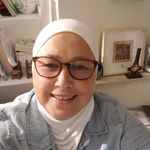History of the Arabic Language
History of the Arabic Language تاريخ اللغة العربيّة
The Arabic language is spoken today by over 250 million people in the Middle East and North Africa. A number of other native languages are also spoken in this part of the world such as Kurdish, Berber, and Mahri. Arabic is also used as a religious language by the world's Muslims, who total around one billion people. Arabic is therefore also learned to various levels of proficiency, as a venerated, liturgical language, by many Muslims mainly in Asia (e.g., Pakistan, Malaysia, China) and Africa (e.g., Senegal).
The language that is spoken by the native speakers of Arabic is usually referred to as "dialect" لـَهْجة. The numerous dialects are purely spoken and are used in parallel to another form of the language that is primarily written but is also spoken in the media today. This co-existence of two forms of the same language to serve different purposes is known as diglossia. This form of Arabic goes back to pre-Islamic poetry and is commonly referred to as fuSHa العَرَبيّةالفـُصحى (elegant or clear language) in Arabic. In English it is called Modern Standard Arabic, Classical Arabic and sometimes literary Arabic or Qur'anic Arabic. While these multiple designations in English seem to offer a breakdown of the different kinds of fuSHa that co-exist today, the Arabic designation sees the different types within a large continuum. This Standard Arabic is standard in that it remains almost exclusively the only recognized language of literacy across the Arabic speaking world. It also enjoys a special position for Arabic speakers because of the large body of texts that has been produced in this form of the language particularly around the golden age of the Islamic civilization. In addition to the Islamic religious texts and the classical Arabic literary texts, major scholarly contributions to the fields of science, medicine, astronomy, mathematics, and sociology for instance were written in the middle ages in this standard Arabic language. Most students learning Arabic as a foreign language tend to get exposure to this standard written language first before they learn a dialect.
Educated speakers of Arabic do mix the standard language and their own dialects to varying degrees depending on the situation. While roughly four major regional dialects of Arabic spoken in the Arab world today have been identified, a multitude of dialectic variations can be noted even within one single country. The four regional dialects are divided into the following general categories: Arabic of the Maghreb (North Africa), Egyptian Arabic (Egypt and the Sudan), Levantine Arabic (Lebanon, Syria, Jordan and Palestine/Palestinians in Israel), and Iraqi/Gulf Arabic. These dialects can differ greatly from one another to the point of mutual unintelligibility.
In terms of language typology, Arabic belongs to the Semitic family of languages. Some of the members of this language family that are spoken today include Arabic, Aramaic (relatively small communities mostly in Iraq and Syria), Amharic (the national language of Ethiopia), Tigre (spoken in Eritrea), and Hebrew (spoken in Israel). There were many other members of this language family which have disappeared over time. These include, for example, Akkadian (spoken in ancient Mesopotamia), Phoenician (spoken in what is today Lebanon), and Eblaite (spoken in ancient Syria).
The Semitic languages first came to light in the Arabian Peninsula. Over the course of millennia these languages spread as different groups left the Arabian Peninsula, carrying their languages with them, into various parts of the Middle East and neighboring areas.
Beginning in the 7th century CE, the Arab Conquests (also known as Islamic or Muslim Conquests) carried speakers of various Arabic dialects, with their religion of Islam and their language of Arabic, out of the Arabian Peninsula into almost all of the Middle East and North Africa, west into the Iberian Peninsula and all the way east to China. Over time, as the incoming Arabs intermarried with indigenous peoples mostly in the Middle East and North Africa, the Arabic language became the prominent language of these regions. While some of the native languages such as Kurdish (Iraq and Syria), Berber (Algeria and Morocco), Mahri (Yemen), and Jebali (Oman) are still spoken in this area, some languages have gradually shrunk. Aramaic, for example, the language that was spoken most widely in the Middle East before the Conquests, is still spoken in pockets in today's Syria and Iraq. In Egypt, the language that was spoken before the Muslims came was Coptic, a direct descendant of the Anciant Egyptian language. Today it only survives as a liturgical language of the Coptic Church.
As a result of the contact Arabic has had with other languages over the past 15 centuries, many languages of the world have borrowed words from Arabic. Persian (a member of the Indo-European language family) and Turkish (a member of the Altaic language family), for example, are replete with Arabic words. The very name of the language "Swahili," spoken in East Africa, is an Arabic word. Spanish and Portuguese have a large Arabic vocabulary (approximately 4000 words) dating back to the eight centuries of contact in the Iberian Peninsula under Muslim rule. English too has its share of words borrowed from Arabic - typically words starting with "al." Some of these words had been borrowed by Arabic speakers themselves from other languages. For example, the English word "alchemy" comes from the Arabic كيمياء. But the Arabic word itself comes from Kemet , which was the name of Ancient Egypt, literally meaning the dark, fertile soil irrigated by the Nile.
February 25, 2019





